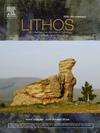Quantifying the contribution of sediment recycling in mantle: A case study of Early Cretaceous gabbroic intrusions in the northeastern North China Craton
IF 2.9
2区 地球科学
Q2 GEOCHEMISTRY & GEOPHYSICS
引用次数: 0
Abstract
Subduction-driven recycling of crustal components plays a crucial role in shaping the compositional heterogeneities of the mantle. However, determining the metasomatic proportion and age of sediment recycling remains challenging owing to the overprinting influence of other slab contributions. This study focuses on two Early Cretaceous (126–123 Ma) gabbroic intrusions from the northeastern North China Craton (NCC), China, which provide insights into how subducted sediments modulate mantle compositions. The olivine gabbro has higher MgO contents and lower FC3MS (FeOT/CaO - 3MgO/SiO2) values, suggesting peridotite-derived melts, relative to the gabbro that originates from pyroxenite mantle sources. The two gabbroic intrusions exhibit arc-like trace element distribution patterns, along with enriched whole-rock Sr–Nd and zircon Hf–O isotopic compositions. These characteristics indicate their derivation from fluxed melting of sub-continental lithospheric mantle sources hybridized by melts derived from ∼5 % terrigenous sediments. Based on the three-stage Pb isotopic growth model, the metasomatized time of the mantle sources occurred in the Late Jurassic (160–150 Ma), which provides new geochemical evidence supporting the Late Mesozoic subduction of the Paleo-Pacific Plate beneath the Eurasian continent. Using the program ABS5, we conducted quantitative calculations to estimate the pressure and temperature of sediment melting, with 3.1–3.2 GPa and 838–842 °C. Thus, our findings not only illustrate the specific contributions (i.e., proportion and age) of sediments input into the mantle, while also highlight the significant role of mantle metasomatism driven by recycled sediments in creating mantle compositional heterogeneities.

地幔沉积物再循环的定量贡献——以华北克拉通东北部早白垩世辉长岩侵入岩为例
俯冲驱动的地壳成分再循环在形成地幔成分非均质性方面起着至关重要的作用。然而,由于其他slab贡献的重叠影响,确定沉积物再循环的交代比例和年龄仍然具有挑战性。本文以华北克拉通(NCC)东北部早白垩世(126-123 Ma)辉长岩侵入岩为研究对象,探讨了俯冲沉积如何调节地幔成分。橄榄岩辉长岩MgO含量较高,FC3MS (FeOT/CaO - 3MgO/SiO2)值较低,表明其熔体来源于橄榄岩,而辉长岩则来源于辉石岩幔源。两种辉长岩侵入体的微量元素呈弧形分布,全岩Sr-Nd和锆石Hf-O同位素组成富集。这些特征表明它们来源于次大陆岩石圈地幔源的熔炼,混合了来自~ 5%陆源沉积物的熔炼。根据三阶段Pb同位素生长模型,地幔源区交代时间为晚侏罗世(160 ~ 150 Ma),为支持晚中生代古太平洋板块在欧亚大陆下俯冲提供了新的地球化学证据。利用ABS5程序进行定量计算,估算沉积物融化压力和温度,温度范围为3.1 ~ 3.2 GPa,温度范围为838 ~ 842℃。因此,我们的发现不仅说明了输入地幔的沉积物的具体贡献(即比例和年龄),同时也强调了由再循环沉积物驱动的地幔交代作用在形成地幔成分非均质性中的重要作用。
本文章由计算机程序翻译,如有差异,请以英文原文为准。
求助全文
约1分钟内获得全文
求助全文
来源期刊

Lithos
地学-地球化学与地球物理
CiteScore
6.80
自引率
11.40%
发文量
286
审稿时长
3.5 months
期刊介绍:
Lithos publishes original research papers on the petrology, geochemistry and petrogenesis of igneous and metamorphic rocks. Papers on mineralogy/mineral physics related to petrology and petrogenetic problems are also welcomed.
 求助内容:
求助内容: 应助结果提醒方式:
应助结果提醒方式:


